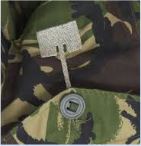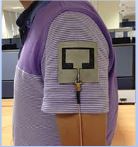Projects:2020s1-2111 Flexible Bio-compatible Materials for Wearable and Conformal Antennas
Contents
Introduction
With the more broadly use in wearable communication systems nowadays, integrating the system onto clothing has become important. The 2111 project team aims to develop two antennas that could be mounted onto clothing for both on-body and off-body modes. The antennas should be bio-compatible and well-performed. The team will define the material and antenna type and use CST as simulation software to examine the performance of the designed antennas. The final fabrication and measurement will be done in labs at the university.
Applications for wearable technology
Wearable communication systems are becoming more relevant in a great number of applications such as medical services and health monitoring. To set up the connection between the body network and external environment, wearable antennas that are mounted onto clothes or human bodies can be developed to meet the needs for different applications. The antennas are required to use bio-compatible materials and fit various movements of body.
Project 2111 Team
Supervisors: Prof. Christophe Fumeaux & Dr. Shengjian Chen
Students: Zhihan Xu & Qun Zhang
Project Plan
Methods
- Search & Learn
Wearable Technology:
Lightweight Ready to use Hands-free use Mechanical flexibility Bio-compatibility
Wearable Antenna: Wireless body antenna network(WBAN)
Challenges: Proximity to the human body Very limited volumes
Materials:
Substrate - PDMS
Polydimethylsiloxane
Initial liquid state
Permittivity & rigidity
Good adhesion
Robustness
Compactibility
Conductor - Metallized Textile Softness lightweight Conformality
- Design
Antenna type
Planar antenna low backward radiation easily integrated lightweight conformal low cost
Frequency Operate at about 2.4 GHz as worldwide standard for ISM bandwidth
Efficiency Adjust relative permittivity for the substrate
Design may change according to the situation/request
- Simulation
- Fabrication
- Measurement
Schedule & Allocation
Budget
Previous Study
Progress
Results
'Mould'
Discussions
Conclusion
References
Future work
More simulation More papers Choose the best design Fabrication Measurement
Aims
Focus on material characterization & design, find the suitable flexible materials
Use PDMS as dielectric and textile material as patch to produce a planar wearable antenna
Seek better performances on/off body
Test the fabricated prototype
Goal
Produce planar antennas with ground plane for both on-body and off-body wearable applications
Method
Search and learn
Calculation - Use Matlab
Simulation
Use CST
Design
on-body mode
off-body mode
Fabrication
Measurement

